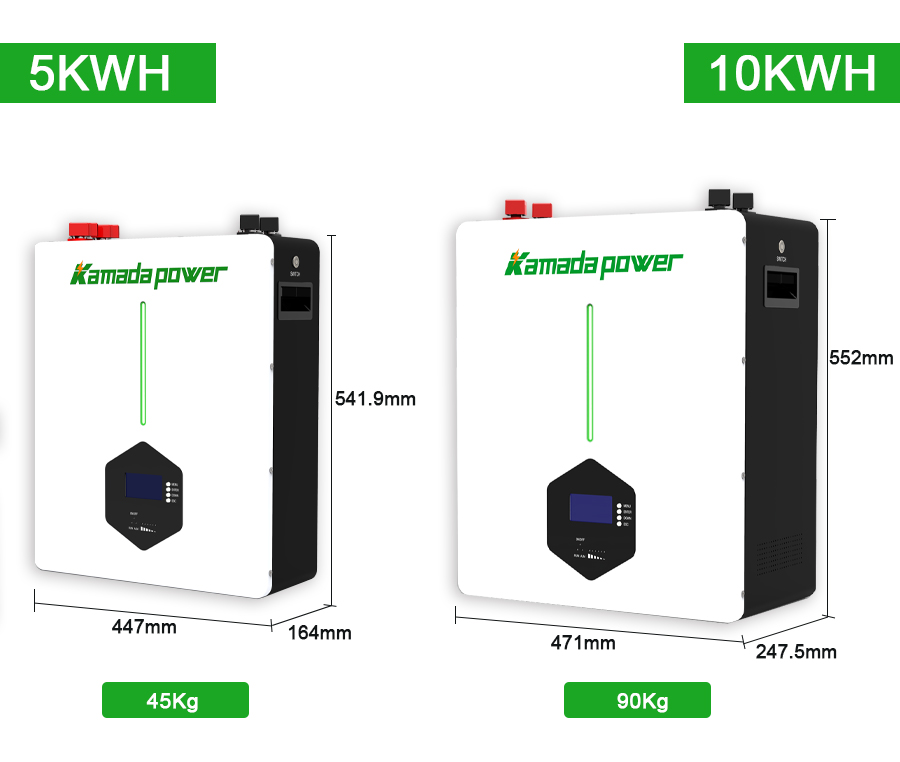Kamada Power Battery Factory stands as a leading powerwall battery factory suppliers manufacturer in china, boasting 15 years of expertise in home solar battery production complemented by a seasoned R&D team.
Our Kamada Powerwall batteries utilize high quality lithium cells and LiFePO4 battery packs, ensuring superior performance and durability. Equipped with an advanced intelligent Battery Management System (BMS), our batteries offer comprehensive protection against overcharging, over-discharging, over-current, short-circuit, and other potential hazards.
For Powerwall battery our support customized options are available including an Product appearance, LCD screen, Bluetooth-enabled real-time control, and a dedicated mobile app. Moreover, our batteries support both series and 15 battery parallel connections, allowing for scalability and increased system capacity and power.
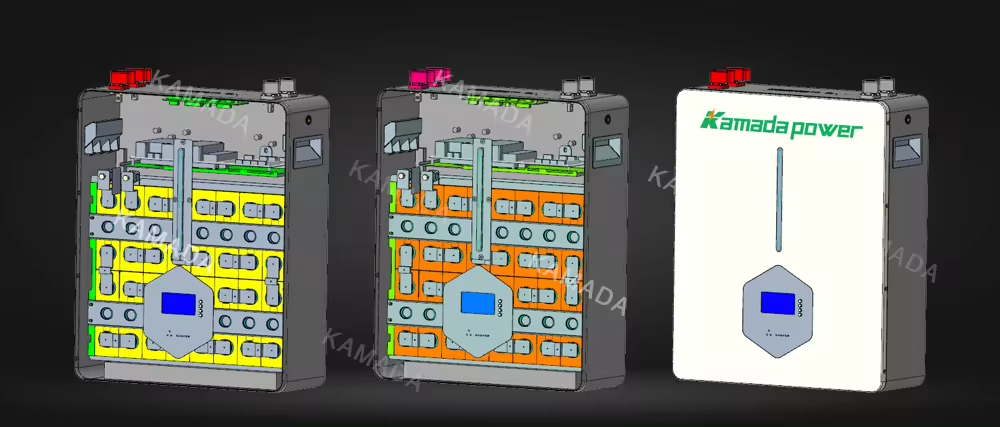
LifePO4 Lithium Battery Performance
Long lifespan
With a lifespan of 6000 cycles at 95% Depth of Discharge (DOD), our batteries offer longevity that is 5 to 10 times greater than traditional lead-acid counterparts.
Reduced Weight
Compared to AGM batteries of equivalent capacity, our lithium batteries weigh only one-third, making them a lightweight and efficient choice.
Optimized Storage Capacity
The self-discharge rate of our LiFePO4 batteries is below 3% of the total capacity over a span of 6 months, ensuring long-term storage without significant loss.
Hassle-Free Maintenance
Our batteries are maintenance-free, eliminating the need for adding distilled water or acid, and reducing overall upkeep requirements.
Rapid Charging Capability
Boasting a fast charge rate of up to 0.5C, our batteries can be fully charged in just 2 hours, providing quick and efficient energy replenishment.
Integrated PCM Protection System
Equipped with built-in protection functions, including overcharge, discharge, current, short-circuit protection, cell balancing, and temperature detection, ensuring comprehensive safety and reliability.
Advanced Safety Features
Our LiFePO4 lithium chemistry offers superior stability, virtually eliminating the risk of explosions or other hazardous incidents.
Eco Friendly Design
Free from harmful elements such as Cd, Mn, Pb, Ni, Co, and Acid, our batteries are environmentally friendly and completely safe for use.
Powerwall Battery Related Products
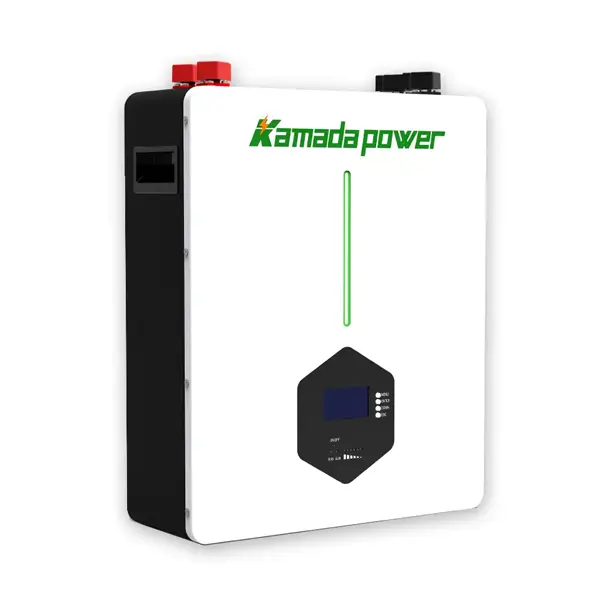 |
Kamada Powerwall Home Battery 10kwh |
What’s a Tesla Powerwall Battery All About?
A Powerwall battery is a rechargeable lithium-ion battery product manufactured by Tesla, designed for home energy storage solutions. According to Tesla’s official website, the Powerwall offers a compact and scalable design, integrating seamlessly with solar panels to store excess energy for use during peak demand times or power outages. With a capacity of up to 13.5 kWh per unit, it provides homeowners with greater control over their energy consumption and costs. The Powerwall also features advanced management software for remote monitoring and control via the Tesla app, ensuring optimal performance and efficiency. As an eco-friendly alternative to traditional energy sources, the Powerwall contributes to reducing carbon footprints and promoting sustainable living.
Why Opt for a Powerwall Battery?
- Boosted Energy Savings: Powerwall batteries excel at maximizing your home’s energy efficiency. They store extra solar power when it’s abundant and use it during peak times, slashing your dependence on the grid and cutting down those monthly electric bills.
- Rock-Solid home Backup Power: Thanks to its smooth integration and lightning-fast response, Tesla Powerwall home battery stands as a rock-solid backup during unexpected blackouts. You can count on a steady power supply to keep your essential appliances and devices running without a hitch.
- Green Energy Champion: Tesla Powerwall battery champions sustainable living by tapping into solar energy and cutting back on fossil fuel reliance. It’s not just good for your wallet; it’s a step towards a cleaner, greener future for both homeowners and our planet.
- Sleek and Adaptable Design: Powerwall battery sleek, modular design ensures hassle-free installation and adaptability. Whether you’re looking to power up a new home or upgrade an existing setup, it’s a perfect fit for diverse energy needs.
- Smart Monitoring and Control: Stay in the know with Powerwall battery advanced monitoring and control features, all accessible right from your Tesla app. Monitor energy usage, fine-tune performance, and get real-time alerts for ultimate peace of mind.
- Built to Last with Solid Warranty: Crafted with top-notch materials and cutting-edge lithium-ion tech, Powerwall home battery is built to go the distance. Plus, with its dependable warranty, it’s a smart, long-term investment that requires minimal upkeep.
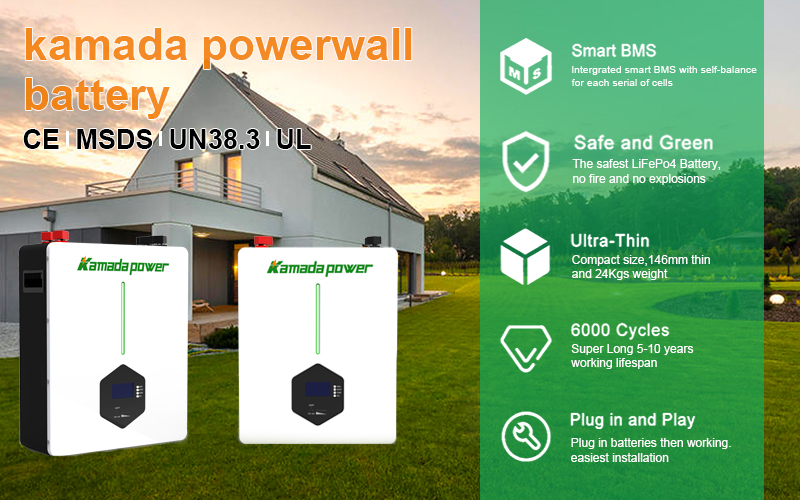
What Makes Up a Powerwall?
Unveiling the Kamada Powerwall Battery
The heart of the Kamada Powerwall beats with 16 advanced 100Ah prismatic lithium cells, all backed by a sophisticated built-in Battery Management System (BMS).
This isn’t your ordinary BMS
it’s a savvy communicator, establishing a seamless link with your inverter via communication ports such as RS485, RS232, and CAN.
Thinking of expanding your energy storage?
Powerwall batteries are built for flexibility, supporting parallel connections that let you scale from 5kWh up to 150kWh and even beyond.
Stay informed with the integrated LCD display, offering real-time insights into voltage, current, capacity, and State of Charge (SOC) at a glance.
And for those who love staying connected, Bluetooth connectivity lets you access and manage all this valuable data right from your smartphone.
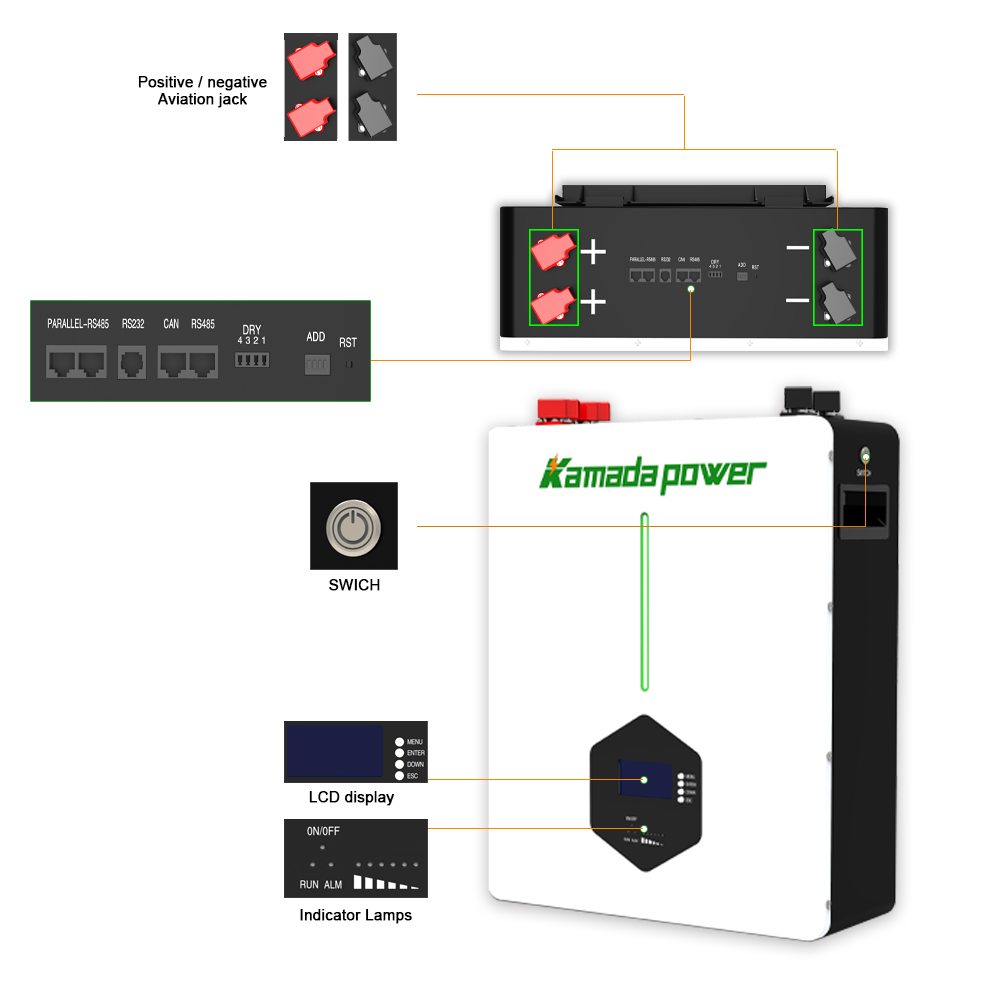
What Kind of Batteries Does the Kamada Powerwall Use?
The Kamada Powerwall utilizes LiFePO4 batteries, known for their exceptional safety, extended lifecycle, and resilience in high-temperature environments, making them the go-to choice for residential energy storage. Data indicates that LiFePO4 batteries have a lower fire risk compared to other lithium-ion types and can endure between 2,000 to 5,000 charge cycles—significantly outperforming traditional lead-acid batteries. These batteries maintain peak performance even in scorching conditions and boast rapid charging capabilities, reaching 80% capacity in just 30 minutes. Moreover, they’re environmentally friendly with a recycling rate exceeding 90%. These compelling stats not only highlight the superior performance of LiFePO4 batteries but also underscore the Powerwall’s commitment to providing homeowners with a durable, reliable, and high-performance energy storage solution.
10 Advantages of Lithium Iron Phosphate Batteries (LifePO4 Battery)
As an alternative to lead-acid batteries, the advantages of lithium iron phosphate batteries are obvious:
- Extended Lifespan: Lasts 5-10 times longer than lead-acid batteries.
- Lightweight: Up to 60% lighter than equivalent lead-acid batteries.
- Enhanced Safety: Lower risk of thermal runaway, backed by industry testing.
- Eco-Friendly: Free from cadmium, manganese, and other toxic materials.
- High Efficiency: Higher energy density with minimal energy loss during use.
- Fast Charging: Capable of faster charging rates, reducing downtime.
- Wide Temperature Range: Performs well in diverse temperature conditions.
- Low Self-Discharge: Retains charge longer when not in use.
- Scalable: Supports parallel connections for easy expansion.
- Versatile: Suitable for a variety of applications including EVs, renewable energy storage, and more.
What’s the Lifespan of a Powerwall Battery?
Typically, lithium batteries last about 10 years, and the Powerwall comes with a 10-year warranty at 70% capacity. Keep in mind, the depth of discharge (DOD) can vary between different brands and products.
How Much Juice Can a Powerwall Hold?
The amount of energy a Powerwall can store varies based on your system setup, which can be customized to fit your specific needs.
How Long Will Your Powerwall Battery Hold Up?
The longevity of a Powerwall battery hinges on two primary factors: its storage capacity and the duration of its use. You can gauge the battery’s endurance by assessing the power needs of your electronic devices.
It’s worth noting that having a solar panel system integrated with your battery can significantly impact its performance and lifespan.
How Does the Powerwall Battery Operate?
As the sun ascends, the solar panels soak up its rays, converting sunlight into usable energy to energize your home. Any surplus energy generated during this phase gets stored in the Powerwall. Once the Powerwall reaches full capacity, any extra energy can be fed back into the grid.
When evening falls and solar panels cease to produce energy, the Powerwall kicks in to supply electricity to your home. This creates a sustainable loop of clean, renewable energy.
If your setup doesn’t include solar panels, the Powerwall can be programmed to charge during off-peak electricity rates and discharge during high-demand or expensive periods. This smart utilization helps in cutting down your electricity bills. During unexpected blackouts, the Powerwall swiftly detects the outage and seamlessly switches to your home’s primary energy source.
How Does the Tesla Powerwall Function During Power Outages?
In the event of a grid failure, the Powerwall instantly senses the disruption and shifts to backup power mode. This ensures your devices stay powered up during outages, providing uninterrupted service without any noticeable glitches.
Can the Powerwall Operate Without Internet?
Absolutely! The Powerwall is engineered to toggle between the most reliable network connections, supporting various internet connectivity options like Wi-Fi, cellular, and wired Ethernet. Once connected, you can effortlessly monitor your Powerwall via the dedicated app and avail of free wireless software updates.
In the absence of an internet connection, the Powerwall continues to function based on its last settings, serving as a reliable backup power source during outages. However, without internet access, you won’t be able to access remote monitoring through the app. Extended periods without an internet connection might hinder software updates and could potentially impact the product warranty.
Can You Achieve Off-Grid Living with the Powerwall?
Absolutely! If you’re eyeing an off-grid lifestyle, the Powerwall batteries are your go-to solution. The latest iteration from Kamada Power supports parallel connections of up to 15 units, offering ample energy storage to cater to your home’s round-the-clock power demands and enabling energy independence. This also proves beneficial for businesses looking to mitigate losses from short-lived power interruptions.
What Devices Can You Energize with a Powerwall?
The Powerwall is designed to cater to various home energy needs, offering reliable backup power solutions for an array of household devices. Let’s break down some common appliances, their required Ampere-hours (Ah), and the potential operating duration on a single Powerwall battery with a 200Ah capacity:
- 120v Lighting Systems: Typically, LED bulbs consume about 0.5Ah per hour. So, a Powerwall could power these lights for approximately 400 hours (200Ah / 0.5Ah).
- Small Household Appliances: Devices like TVs, laptops, and routers may require around 1Ah per hour. This means you could run them for roughly 200 hours on a fully charged Powerwall.
- 240v Air Conditioning Units: Depending on the size and efficiency of the unit, an air conditioner might use between 15-20Ah per hour. With a Powerwall, you could potentially run it for about 10-13 hours.
- Refrigerators and Freezers: These appliances typically consume around 1-2Ah per hour. A Powerwall could keep them running for approximately 100-200 hours.
- Microwave Ovens: A microwave might use around 10-15Ah for a short duration of use. On a Powerwall, you could operate it for roughly 13-20 hours.
- Water Heaters: Depending on the type and size, water heaters can use between 10-15Ah per hour. With a Powerwall, you might get 13-20 hours of operation.
- Electric Dryers: These appliances are energy-intensive, consuming around 20-30Ah per cycle. A Powerwall could run a dryer for about 6-10 hours.
Remember, these are estimated figures and actual durations may vary based on factors like device efficiency, usage patterns, and Powerwall performance. Customizing your Powerwall setup according to your specific energy needs can help optimize its performance and provide reliable backup power tailored to your household requirements.
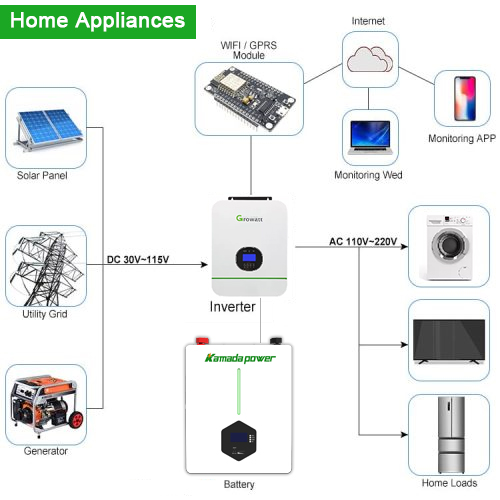
How Many Powerwall Battery Do I Need?
To determine the number of Powerwalls you might need for your home, it’s essential to consider your backup power requirements rather than trying to replace your entire home’s electricity consumption. Powerwalls are designed to act as a reliable backup power source to keep essential appliances running during outages or peak demand times.
Based on the assumption that you’d want the Powerwalls to provide backup power for approximately one day without considering solar or other renewable energy sources, the calculation can be straightforward.
Each Powerwall has a capacity of 10 kWh. If we estimate a daily backup power requirement of 29.23 kWh (based on the average monthly consumption of 877 kWh divided by 30 days), the calculation would be:
Number of Powerwall Battery Needed = Daily Backup Power Requirement / Capacity of a Single Powerwall
Number of Powerwall Battery Needed = 29.23 kWh/day / 10 kWh/Powerwall = 2.923
Rounding up to the nearest whole number, you would likely need about 3 Powerwalls to meet your daily backup power needs. This approach aligns more closely with the practical application of Powerwalls as backup power sources rather than primary energy providers for an entire household.
How Much Is A Powerwall Battery?
the cost of a Tesla Powerwall battery in the United States typically ranges between $7,000 and $8,000, excluding installation costs. The final price can vary based on factors such as location, local taxes, additional equipment needed for installation, and any available incentives or rebates.
Remember, the cost of a Powerwall is just one factor to consider. It’s essential to evaluate your specific energy needs, potential savings, and the overall benefits of having a reliable backup power source when determining if a Powerwall is the right choice for your home.
Where Can I Purchase a Powerwall?
Tesla pioneered the whole wall-mounted energy storage game and set the gold standard in the biz. But these days, there are also a bunch of other energy companies rolling out their own versions of home battery setups. If you’re in the market for a Tesla Powerwall, your best bet is to hit up an authorized Tesla dealer or distributor. Alternatively, you might want to check out other options like the Kamada Powerwall battery.
Before pulling the trigger on a purchase, it’s crucial to nail down your specific energy needs. Chatting with design engineers or energy consultants can be a game-changer. They can help you figure out the best fit for you in terms of specs and design. This kind of consultation can really make sure your investment matches up with both your energy goals and your budget.
How Large Is a Powerwall Battery?
Powerwall batteries come in various sizes depending on their specifications. Take the Tesla Powerwall 2, for instance. It stands at about 45 inches tall, spans 30 inches in width, and has a depth of roughly 6 inches. On the other hand, the Kamada Powerwall Battery measures 21.54 inches in length, 18.54 inches in width, and 9.76 inches in height.. For a detailed look at the specifications, you can check out the Kamada Powerwall battery datasheet by clicking the provided link.
Below, we’ve included a visual comparison showcasing the sizes of the Kamada Powerwall 5kWh and 10kWh lifepo4 batteries for a clearer perspective.
Where Should You Install The Powerwall?
The ideal location for installing a Powerwall largely depends on your home’s layout and energy needs. Typically, it’s best to place the Powerwall in a cool, dry area, away from direct sunlight, to optimize its performance and longevity. Many homeowners opt to install it in a garage, utility room, or on an exterior wall close to the main electrical panel for easier integration with the home’s electrical system. Ensuring it’s easily accessible for maintenance and inspections is also crucial. Consulting with a professional installer can provide personalized guidance tailored to your specific home and energy setup.
Are There Tesla Powerwall Alternatives?
Since Tesla launched Powerwall, other companies have also launched alternative wall-mounted household battery backup products one after another.
As a supplier of powerwall solar cells, we also recommend Kamada Power home energy storage products. 48V, 51.2V, 5kwh, 10kwh, 15kwh, other parameters can also be customized.
Conclusion
We’ve delved into the typical issues with the powerwall battery. Based on this information, you can decide if investing in a powerwall is the right choice for you. Essentially, powerwall batteries harness solar energy efficiently, helping to cut down on your power costs and paving the way for energy self-sufficiency. They’re a great fit for both home and business settings.
About Kamada Power Is Leading Powerwall Battery Factory In China
Since 2014, Kamada Power has been at the forefront of lithium battery solutions
From our inception in 2014, we’ve been all about innovation, top-notch quality, and unmatched reliability. We’ve set up a specialized division crafting lithium batteries tailored for home, commercial, and industrial energy storage needs with cost-effective solutions.
Moreover, Kamada Power stands out for its expertise in customizing lithium battery products across various sectors, including rack battery,hv battery,powerwall home battery for solar system,server rack battery,and low-speed power applications like golf carts and AGVs and RV battery.
Our Certifications Our products don’t just meet but exceed industry standards, holding certifications from UL 9540, UL 1973, CE, MSDS, UN38.3, ISO, and IEC, rigorously tested and verified by internationally recognized labs.
Quality and Trustworthiness Each batch of our products undergoes a 100% stringent quality inspection before shipping out. As a genuine Lifepo4 battery factory based in Shenzhen, China, we operate from a state-of-the-art facility spanning 1800 square meters.
Why Choose Kamada Power Battery
- Robust Team and Infrastructure: Boasting over 200 seasoned engineers and assembly line workers and an expansive 1800-square-meter facility.
- Customization at Its Best: With 26 experienced engineers on standby, we offer top-notch OEM/ODM services, catering to various voltage, current, capacity, and size requirements.
- Cost-Efficiency: Delivering high-quality energy battery storage solutions at factory-direct prices from China, saving you both budget and time.
- Comprehensive Certification and Assurance: Our products come with a slew of certifications including CE, UL, CB, ISO, MSDS, and UN38.3, ensuring product safety and reliability.
- Customer-Centric After-Sales Service We offer a 5-year warranty, round-the-clock professional customer support, complimentary new battery replacements, and ongoing technical and marketing assistance to ensure your satisfaction and trust.
Post time: Apr-03-2024


